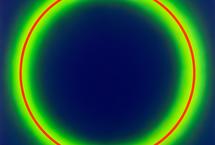Galeria Javier Lopez is pleased to present a selection of works on paper to close the cycle dedicated to Minimal Art and initiated by the collective exhibit ‘Extended Minimalism.’ On this occasion, the gallery has selected an ensemble of works produced in similar mediums – silk-screens and lithographs on paper – and that share in common a minimalist approach – that has served to set guidance to the previous project. All works are limited editions of great quality. The artists at show are currently the most sought-after by collectors, and the gallery is thrilled to show for the first time an ensemble of their works (Yturralde being the exception as his work has been previously at display). The exhibition brings to the forefront interpretations on minimalist principles that stem from figures such as Ad Reinhardt, Ellsworth Kelly and Gerhard Richter, and further includes the work of Stephanie Brooks, a younger artist who’s work is at display for the first time in Spain.
Ad Reinhardt (New York, 1913 - 1967) is considered a pioneer in the field of conceptual and minimal art. He is regarded as one of the leading representatives of the Neo-dada movement. His early works would break away from representation and expressionist tendencies. Reinhardt’s compositions of geometric forms reflect his developing interest in color hues (red, blue and white). He is best known for his so-called ‘black paintings’ from the sixties. From this period, the gallery presents a group of ten silk-screens from 1966; a remarkable work of rich complexity characterized by a subtle chromatic variation.
Ellsworth Kelly (Newburgh, New York, 1923) studied art in prime schools in Brooklyn and Boston. In Paris he became involved with European avant-garde. Real-life observations are the backbone of his abstraction works; his compositions represent conceptual ideas such as the spaces in between architectural elements or projected shadows from trees. His flat monochromatic canvases explore form and depth –proposing random compositions characterized by recombined panels.- In doing so, the artist expands modern art’s pictorial vocabulary. The color lithographs selected represent three different decades of artistic production. In this way, the show aims to bring to light the formal and conceptual coherence of the artist’s art production.
Gerhard Richter (Dresden, 1932) began his artistic carrier painting murals. His experience during the sixties covers the avant-garde tendencies of Pop Art and Abstract Expressionism. During this period, he developed a figurative tendency. As a base, he borrowed photographs of landscapes, still life’s or family portraits, which he then reinterpreted in a realist and austere style. Fond of Art History, his works echoes that of Vermeer, Friedrich, Duchamp or de Kooning. Richter’s abstract facet has undergone a constructive and monochromatic phase tending to privilege Minimalist aesthetics. The silk-screen on display reflects Richter’s interest in perceptual perspectives that arouse in association to form and color.
José María Yturralde (Cuenca, 1942) since his start he has been interested in researching the meeting point between art and science. Following his contact with artists close to Zóbel, the establishment of the Museo de Arte Abstracto Español in Cuenca and his involvement in the valencian movement ‘Antes del Arte,’ he decided to pursue his interest at Centro de Cálculo at Universidad Complutense. He would then attend the Center for Advanced Visual Studies at MIT in the United States. Yturralde’s scholarly concentration in the relationship between time and space is captured in his series ‘Figuras Imposibles.’ Further, it was his first reflections materialized in these works what foremost gained the artist international recognition – mainly due to his revolutionary contributions in the field of optical and kinetic art.- Coinciding with the 40th anniversary of his experience at the Centro de Cálculo in Madrid, the gallery is pleased to display two works from 1972 that exemplify this period of artistic production.
The work of Stephanie Brooks (Chicago, 1970) is conceptually humoristic and formally intelligent. Her work analyzes the power – hidden in most cases – that governs standardized accepted systems. Brooks then studies the impact that these regulations have upon the private life of individuals. The artist extracts texts from self-help booklets and bureaucratic forms. Once re-configured, the texts serve her to highlight the multiple meanings inherent in our language. Her series, ‘Something Important, Concealed,’ presents a composition based on a scribbled text. The illegible text instantly arouses the viewer’s curiosity. The degree of intrigue over the content of the concealed message depends on the relevance the viewer considers the text to bear.
